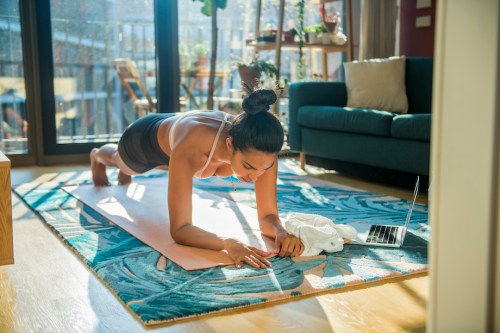Having a strong core is essential to all movement. A strong core helps stabilize your lumbar spine and pelvis, allows you to perform movements like twisting and bending, and can even improve your athletic performance. There are a plethora of ab exercises you can do to strengthen your core, and planking is one of the most popular. But while planks appear in countless workouts, it can be easy to do them with improper form. One of the most common errors people make when starting a plank is forgetting to activate their glute and abdominal muscles. To help you perfect your plank form and teach you how to properly start a plank, we spoke to Chip Coleman, CSCS, co-founder of Motus Performance.
Experts in This Article
Chip Coleman, CSCS, is the co-founder of Motus Performance in Tucson, Arizona.
“When you take something as simple as a plank, everybody gets into a plank in a very similar manner. They get down on their hands and knees and they throw their hips up in the air,” Coleman says. While this may seem normal, two common technique errors Coleman sees when people start this way are coming into the plank with an anterior pelvic tilt, “with a big arch in their back,” and coming into a plank with high hips as if they’re in a pike position. These errors happen because your body naturally wants to move into positions that require less muscle energy, especially if you have a weak core or aren’t accustomed to performing planks, Coleman says.
If you tend to perform planks with an arched or swayback, you may feel your quads working a little bit but ultimately, “you’re really not activating any core musculature directly, you’re just resting on your spinal tissues and discs and joints,” Coleman says. This can lead to injury over time, and it’s imperative you protect your spine by putting it in an optimum position, which has a lot to do with the position of your pelvis, according to Coleman. “Whatever tendency you have, if you don’t set your pelvic position well, you’re not ever going to really activate your core musculature in a way that is protective of the spine.” Additionally, when it comes to the plank, you won’t activate your anterior core muscles like you’re supposed to and reap the strengthening benefits of the exercise.
In order to get your plank form on point, Coleman advises starting off by laying flat on your stomach. “If I know everybody’s laying flat on their stomach and they can track their glutes, the hips automatically push forward.” From there, the goal is to maintain the position of the hips while keeping both your glutes and core activated as you lift up into a plank position, maintaining that activation throughout the duration of holding the plank.
It may feel foreign at first to co-contract your glute and core muscles, but by doing so, it enables the hips to keep the pelvis “in that nice, flat alignment. And then the core is learning to stay in that really strong, natural lumbar curve rather than a super-arch or high pike position,” he says. It may take some time to nail down these new cues, which is why Coleman recommends having verbal feedback from a coach or simply paying more attention to your technique whenever you perform a plank.
For beginners or anyone who thinks their form could use some improvement, Coleman advises implementing these cues from a high-plank position in order to build muscular endurance and your core musculature. From there, you can progress to the elbow plank. You can also use this tip when you’re performing other plank variations such as a side plank, he says.
If you opt to do more dynamic variations like up-down planks, Coleman cautions that they can “kick somebody into their incorrect habit movement,” and you may fall out of conscious muscle recruitment and utilize any method that will allow you to hold a plank regardless of your form. You don’t have to cut dynamic variations from your program, but “make sure you’re solid in any kind of static planking position before you move to something dynamic,” he advises. If you’re ready to improve your plank technique, follow the simple steps below.
How to hold a plank properly
1. Start by lying flat on your stomach, and with control, engage your glute and abdominal muscles.
2. While still engaging your glutes and abdominal muscles, push yourself away from the floor, either from your hands or elbows or forearms, to protract your scapulae (your shoulder bones). Your elbows and hands should be directly underneath your shoulders and your body should be in a straight line from head to toe.
3. Hold for the designated amount of time.
Visual learner? Try this:
Oh hi! You look like someone who loves free workouts, discounts for cult-fave wellness brands, and exclusive Well+Good content. Sign up for Well+, our online community of wellness insiders, and unlock your rewards instantly.
Sign Up for Our Daily Newsletter
Get all the latest in wellness, trends, food, fitness, beauty, and more delivered right to your inbox.
Got it, you've been added to our email list.











